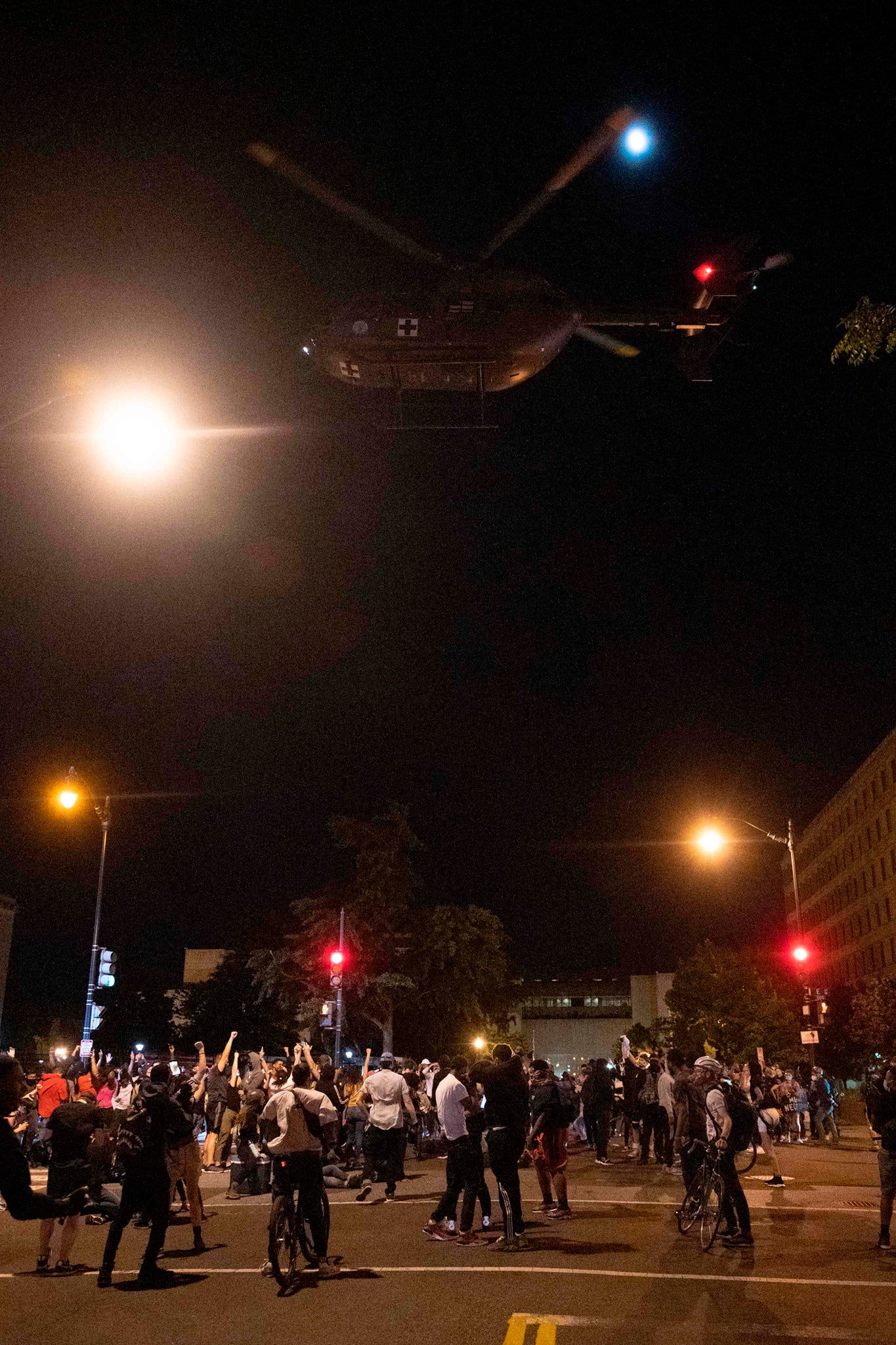George Floyd protests: Red Cross medical helicopters used to target demonstrators in possible breach of Geneva Convention
Investigation launched into 'foolish' deployment
On the battlefield, the roar of helicopter blades paired with a Red Cross is salvation for wounded troops and civilians.
But the thwomping blades of military helicopters, including one with Red Cross markings, were part of a low-flying show of force over Washington's streets on Monday night - an incident now under investigation.
Numerous videos on social media showed an unarmed Lakota medevac helicopter hovering over demonstrators. Its Red Cross markings, visible on the aircraft's belly and side, was flown by the District of Columbia Army National Guard.
The use of a helicopter with Red Cross markings was an abuse of global norms that could help erode its neutral symbolism, military justice experts said.
“This was a foolish move,” said Geoffrey Corn, a former Army lawyer and professor at the South Texas College of Law in Houston. “The symbolic significance of the Red Cross is pervasive: It denotes a 'noncombatant' function of the armed forces.”
The National Guard has been used to augment police across the country, defence officials have insisted, including 18,000 Guard members in 29 states and DC mobilised in response to unrest after the killing of George Floyd by police in Minneapolis last week.
The use of a helicopter's rotor wash, the downward rush of air from its rotors, is a common military tactic to incite fear, disperse crowds and warn of other capabilities, like rockets and guns, said Kyleanne Hunter, a former Marine Corps pilot who flew Cobra attack helicopters in Iraq and Afghanistan.

Ms Hunter, now a senior adjunct fellow at the Centre for a New American Security in Washington, said she flew low over civilian vehicles to disperse them ahead of convoys in Iraq.
And after reviewing videos of the helicopter, she concluded that it flew far too low to be on a surveillance mission.
“You add more military equipment, you get more military tactics,” she said. “It's to provoke and incite rather than protect and serve.”
Major General William Walker, commander of the DC National Guard, has directed an investigation into the “low-flying manoeuvre”, a spokesperson said on Tuesday evening. The decision to use the manoeuvres was authorised by the highest levels of that command, The New York Times reported.
Guard members were among the local and federal law enforcement officers that cleared out Lafayette Square on Monday to allow Donald Trump a photo-op at a nearby church, but they did not have, and did not fire, tear gas or rubber bullets, defence officials said.
But the use of medevac helicopters during demonstrations after curfew stunned justice experts, who said the Red Cross symbolises mercy.
“Misuse of the Red Cross symbol is prohibited even during peacetime by the First Geneva Convention, to which the US is a party,” said Rachel VanLandingham, a former Air Force attorney and professor at the Southwestern Law School in Los Angeles.
Linking the symbol with law enforcement, Ms VanLandingham said, can weaken its “effectiveness as signifying medical and humanitarian assistance, a symbol of trust that is needed to give those vehicles with that symbol needed access where they are needed during armed conflict”.
It is unclear whether the helicopter was one of few available. Ms VanLandingham said it might have been prudent to consider covering up the Red Crosses before flight.
The use of the helicopter also may violate Army regulations, Mr Corn said, including domestic operations that outline the use of medical resources for “the evacuation of patients, movement of medical supplies and personnel, and support of search and rescue activities”.
Flying low in urban areas presents numerous risks to the pilots, crew, aircraft and people on the ground, Ms Hunter said, factors that are typically considered before flying such a mission.
Helicopters are not as aerodynamic as aeroplanes, so in the event of a malfunction, pilots need to assess their altitude, speed and weight before calculating what to do. One solution, Ms Hunter explained, is to rotate the aircraft so air can move over the blades - an attempt to control the helicopter into a crash landing.
But the presence of protesters on the ground, buildings on all sides and a low altitude would make such a manoeuvre “virtually impossible” in the event of engine failure, Ms Hunter said. The best a pilot could hope for at that altitude, she said, is minimising injuries on the ground.
The Washington Post
Join our commenting forum
Join thought-provoking conversations, follow other Independent readers and see their replies
Comments
Bookmark popover
Removed from bookmarks